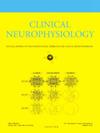Central auditory processing deficits in essential tremor
IF 3.7
3区 医学
Q1 CLINICAL NEUROLOGY
引用次数: 0
Abstract
Introduction
Central auditory processing (CAP) deficits are is emerging heterogeneous non-motor symptoms of essential tremor (ET). This study characterized CAP abilities of ET and examined correlations with tremor onset age and severity.
Methods
In this prospective cross-sectional study, CAP in ET participants was compared to age, gender, and education-matched healthy controls (HC). Tremor severity was assessed using Fahn-Tolosa-Marin rating scale. CAP was evaluated using the gap in noise (GIN) test, and auditory evoked potentials [Late latency response (LLR) and P300]. LLR parameters (P1-N1-P2-N2) were measured using speech stimulus at Cz, while P300 parameters (P3b) were recorded using both tonal & speech stimuli at Fz, Cz, and Pz.
Results
ET participants showed significantly poorer GIN compared to HC. LLR revealed shorter N2 latencies, while P3b showed prolonged latencies and smaller amplitudes at Fz, Cz, and Pz for both tonal and speech stimuli. GIN parameters correlated with tremor onset and severity, while P3b (Fz) correlated with tremor onset age.
Conclusion
Findings indicate poor temporal resolution and higher cognitive sensory deficits in auditory processing in ET, implicating the involvement of multiple cortical and subcortical circuits.
Significance
These findings strengthen evidence of non-motor involvement in ET, highlighting auditory processing as a potential clinical attention.
特发性震颤的中枢性听觉处理缺陷
中枢听觉加工(CAP)缺陷是特发性震颤(ET)的异质非运动症状。本研究描述了ET的CAP能力,并检查了与震颤发病年龄和严重程度的相关性。方法在这项前瞻性横断面研究中,将ET参与者的CAP与年龄、性别和教育程度相匹配的健康对照组(HC)进行比较。采用Fahn-Tolosa-Marin评分量表评估震颤严重程度。采用噪声间隙(GIN)测试和听觉诱发电位[晚潜伏期反应(LLR)和P300]评估CAP。在Cz处使用语音刺激测量LLR参数(P1-N1-P2-N2),而P300参数(P3b)使用音调&;Fz, Cz和Pz的语音刺激。结果与HC相比,set参与者的GIN明显较差。在音调和言语刺激下,LLR表现出较短的N2潜伏期,而P3b表现出较长的潜伏期和较小的Fz、Cz和Pz振幅。GIN参数与震颤发作和严重程度相关,P3b (Fz)与震颤发作年龄相关。结论ET的听觉加工存在时间分辨率差和认知感觉缺陷,可能涉及多个皮层和皮层下回路。这些发现加强了非运动参与ET的证据,突出了听觉处理作为一个潜在的临床关注。
本文章由计算机程序翻译,如有差异,请以英文原文为准。
求助全文
约1分钟内获得全文
求助全文
来源期刊

Clinical Neurophysiology
医学-临床神经学
CiteScore
8.70
自引率
6.40%
发文量
932
审稿时长
59 days
期刊介绍:
As of January 1999, The journal Electroencephalography and Clinical Neurophysiology, and its two sections Electromyography and Motor Control and Evoked Potentials have amalgamated to become this journal - Clinical Neurophysiology.
Clinical Neurophysiology is the official journal of the International Federation of Clinical Neurophysiology, the Brazilian Society of Clinical Neurophysiology, the Czech Society of Clinical Neurophysiology, the Italian Clinical Neurophysiology Society and the International Society of Intraoperative Neurophysiology.The journal is dedicated to fostering research and disseminating information on all aspects of both normal and abnormal functioning of the nervous system. The key aim of the publication is to disseminate scholarly reports on the pathophysiology underlying diseases of the central and peripheral nervous system of human patients. Clinical trials that use neurophysiological measures to document change are encouraged, as are manuscripts reporting data on integrated neuroimaging of central nervous function including, but not limited to, functional MRI, MEG, EEG, PET and other neuroimaging modalities.
 求助内容:
求助内容: 应助结果提醒方式:
应助结果提醒方式:


